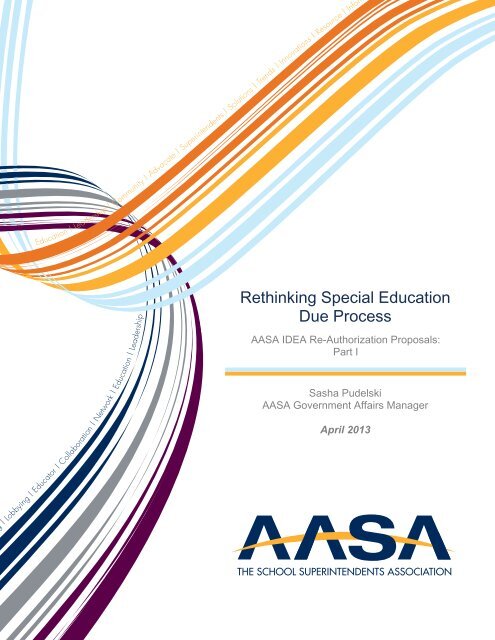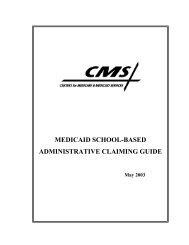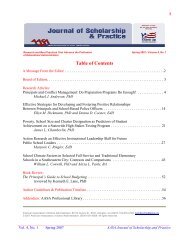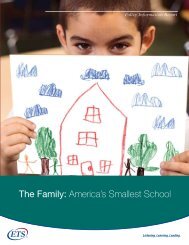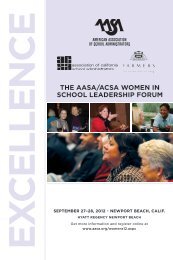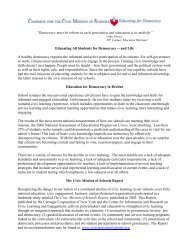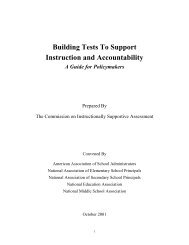Rethinking the Special Education Due Process System - American ...
Rethinking the Special Education Due Process System - American ...
Rethinking the Special Education Due Process System - American ...
Create successful ePaper yourself
Turn your PDF publications into a flip-book with our unique Google optimized e-Paper software.
- 2 -Executive SummaryThe re-authorization of IDEA should have occurred in 2011, but <strong>the</strong> delay of ESEA and o<strong>the</strong>r criticaleducation legislation has meant that advocacy groups are only beginning to introduce legislative fixes orpolicy recommendations in 2013. AASA has begun to compile recommendations for <strong>the</strong> next reauthorizationof IDEA and <strong>Rethinking</strong> <strong>the</strong> <strong>Special</strong> <strong>Education</strong> <strong>Due</strong> <strong>Process</strong> <strong>System</strong>, is <strong>the</strong> first report in ourseries that addresses problems with <strong>the</strong> current statute as well as proposed improvements. <strong>Rethinking</strong> isintended to spark a thoughtful, new dialogue about <strong>the</strong> need for critical changes to <strong>the</strong> special educationdispute resolution system. The report contends modifications to <strong>the</strong> current due process system couldgreatly reduce, if not eliminate, <strong>the</strong> burdensome and often costly litigation that does not necessarilyensure measureable educational gains for special education students. At <strong>the</strong> same time, AASA’s proposalpreserves <strong>the</strong> right for parents to move forward with litigation against a district and maintains o<strong>the</strong>reffective dispute resolution models that were put in place in <strong>the</strong> prior re-authorizations.Why should policymakers reconsider <strong>the</strong> current due process system in <strong>the</strong> next IDEAreauthorization?District compliance with IDEA is radically different today than when IDEA was created over threedecades ago. Until recently, requesting a due process hearing was <strong>the</strong> only meaningful way for parents toknow definitively whe<strong>the</strong>r a school district was fulfilling its obligations under IDEA. However, majorchanges to <strong>the</strong> federal accountability and compliance monitoring system for students with disabilitiesunder No Child Left Behind (NCLB) and IDEA 2004 have opened <strong>the</strong> door to potential alternatives todue process hearings that would benefit all parties.The complex system of compliance indicators developed in <strong>the</strong> last reauthorization of IDEA, coupledwith <strong>the</strong> subgroup accountability system of NCLB, resulted in increased attention on <strong>the</strong> part of schooldistricts to improve educational outcomes for students with disabilities or be subject to a broad range ofpenalties and oversight. For example, if districts could not prove <strong>the</strong>y were increasing academicachievement rates for all students with disabilities, or if districts were found noncompliant with aparticular statutory requirement for a single student with a disability, <strong>the</strong> school systems would undergointensive monitoring by state and federal departments of education and risk losing federal funds. AASAbelieves <strong>the</strong>se changes have made schools and school districts far more compliant with IDEA and morefocused on improving <strong>the</strong> academic outcomes of students with disabilities.On <strong>the</strong> o<strong>the</strong>r hand, a close review of <strong>the</strong> current due process procedures suggests that <strong>the</strong> current dueprocess system continues to expend considerable school district resources and impedes <strong>the</strong> ability ofschool personnel to provide enhanced academic experiences for all students with disabilities because itdevotes <strong>the</strong> district’s precious time and resources to fighting <strong>the</strong> legal actions of a single parent. A newstrategy for dispute resolution should be considered given <strong>the</strong> lack of evidence demonstrating thatstudents who invoke due process protections fare better academically after <strong>the</strong> hearings. Given <strong>the</strong>scarcity of education dollars, it is worth reassessing <strong>the</strong> maintenance of an unproved system forchallenging special education disputes. O<strong>the</strong>rwise, significant dollars, time, and emotional capitol willcontinue to be expended on a process that has little, if any, real connection to improving educationoutcomes.
- 5 -IntroductionIn 2010, 95% of all U.S. students with disabilities were educated in public schools; 2 in 1970, <strong>the</strong> numberwas only 20%. 3 It is a major victory for both education and civil rights advocates that students withdisabilities are now present in every school in <strong>the</strong> country. Federal education law passed over 30 yearsago made <strong>the</strong> radical recomposition of America’s classrooms possible, but <strong>the</strong> large jump in <strong>the</strong> numberof students educated in public schools was catalyzed by <strong>the</strong> federal courts. Judicial decisions inPennsylvania Association for Retarded Children (PARC) v. Commonwealth of Pennsylvania 4 and Millsv. Board of <strong>Education</strong> 5 declared that students with disabilities were constitutionally guaranteed <strong>the</strong> rightto be educated in public schools. The courts also specified that students with disabilities were entitled toreceive educational services within <strong>the</strong> public school system; in PARC, this was defined as a “publicprogram of education and training appropriate to <strong>the</strong> child’s capacity,” while in Mills, this was defined asa “free and suitable publicly-supported education.” Never before was <strong>the</strong> right to an “appropriate” or“suitable” education conferred on a subset of students.In 1975, Congress, under steady pressure from disability rights advocates, educators and parents, passed<strong>the</strong> <strong>Education</strong> for All Handicapped Children Act (EAHCA), which “guaranteed a supplementary set ofrights to children classified as handicapped.” 6 The statute included <strong>the</strong> right to an “appropriate education”in <strong>the</strong> “least restrictive environment” with <strong>the</strong> provision of “related services.” 7 Under <strong>the</strong> EAHCA,parents were allowed to request a special education evaluation for <strong>the</strong>ir child and consent or revokeconsent to special education. Parents were also given <strong>the</strong> right to ask for an independent educationevaluation at public expense when <strong>the</strong>y disagreed with <strong>the</strong> school district’s special education assessment.Most importantly, if parents believed <strong>the</strong>ir child was not receiving an appropriate education, <strong>the</strong>y couldrequest a due process hearing overseen by an independent hearing officer where <strong>the</strong>y could be representedby counsel, call and cross-examine witnesses, and examine records relating to <strong>the</strong> child. 8The due process provisions in <strong>the</strong> EAHCA, today known as <strong>the</strong> Individuals with Disabilities <strong>Education</strong>Act, were nearly identical to <strong>the</strong> provisions ordered by <strong>the</strong> court in PARC. However, Congress’ decisionto leave <strong>the</strong> enforcement of students’ rights to parents stands in a stark contrast to o<strong>the</strong>r civil rightslegislation that was enacted during this period. For example, when Congress passed Title VI of <strong>the</strong> Civil2 Four percent of students with disabilities are enrolled in segregated education placements (publicly and privately funded), and less than 1% of students are in separateresidential facilities, or in hospital or homebound placements.<strong>American</strong> Youth Policy Forum and Center on <strong>Education</strong> Policy. (2002). “Twenty-Five Years of Educating Children With Disabilities: The Good News and <strong>the</strong> Work Ahead.”Washington, D.C.: Author.3 Aud, S. and G. Hannes, eds. (2012). “The Condition of <strong>Education</strong> 2011 in Brief.” NCES 2011-034. Washington, D.C.: U.S. Government Printing Office.4 Pennsylvania Association for Retarded Children (PARC) v. Commonwealth of Pennsylvania, 334 F. Supp. 1257 (E.D. PA 1971).5 Mills v. Board of <strong>Education</strong>, 348 F. Supp. 866 (D. DC 1972).6 Engel, D.M. (1991). "Law, Culture, and Children with Disabilities: <strong>Education</strong>al Rights and <strong>the</strong> Construction of Difference." Duke Law Journal 166: 180-205.7 Congress enacted <strong>the</strong> <strong>Education</strong> for All Handicapped Children Act (<strong>the</strong> “EAHCA”) in 1975. Pub. L. No. 94-142, 89 Stat. 773 (codified as amended at 20 U.S.C.A. §§ 1400–1487)8 20 U.S.C. §1415
- 6 -Rights Act in 1964, <strong>the</strong> Office of Civil Rights within <strong>the</strong> Department of Health, <strong>Education</strong>, and Welfarewas charged with ensuring black students would be educated alongside <strong>the</strong>ir white peers in <strong>the</strong> publicschool system. Similarly, Title IX, 9 which was added to <strong>the</strong> Higher <strong>Education</strong> Act of 1965 in 1972, didnot leave to her parents <strong>the</strong> enforcement of a female student’s right to equal education opportunities. Butwith EAHCA, advocates believed a student’s right to a “free appropriate public education in <strong>the</strong> leastrestrictive environment” 10 (FAPE in <strong>the</strong> LRE) could not be adequately monitored by a singleadministrative agency. 11 Then and now, students with disabilities are <strong>the</strong> only persons with individualizedand statutorily created remedies in <strong>the</strong> form of entitlements in our schools. O<strong>the</strong>r students, including “atrisk”students, receive targeted services only when school budgets allow, and <strong>the</strong>ir parents have no legalright to assert claims or demand services. 12 I. Flaws in <strong>the</strong> current special education due process system● ● ●“…ra<strong>the</strong>r than detailing <strong>the</strong>substantive rights of children withdisabilities, <strong>the</strong> EAHCA created anovel relationship between <strong>the</strong>irparents and school districtpersonnel and developed a set ofprocedures to regulate thatrelationship. Thus, in schooldistricts across <strong>the</strong> United States,<strong>the</strong> fate of millions of children withdisabilities came to depend on <strong>the</strong>peculiar dynamics of <strong>the</strong> interactionbetween parents and localeducators.”— David Engel● ● ●There are many reasons for questioning <strong>the</strong> efficacy of <strong>the</strong> currentdue process system. First, as a result of major changes to key piecesof federal education legislation, due process is no longer <strong>the</strong> majorlever for ensuring students with disabilities are provided anindividualized plan that “confers an educational benefit.” 13 From <strong>the</strong>1980s to <strong>the</strong> early 2000s, <strong>the</strong> Individuals with Disabilities <strong>Education</strong>Act’s due process provisions were critical to safeguarding <strong>the</strong> rightsof students with disabilities because state and federal oversight ofdistrict special education programs was minimal. Requesting a dueprocess hearing or filing a state complaint were <strong>the</strong> only meaningfulways for parents to know definitively whe<strong>the</strong>r a school district wasfulfilling its obligations under IDEA to specifically serve <strong>the</strong>ir child.But <strong>the</strong> 2001 No Child Left Behind Act (PL 107-110) (NCLB) and <strong>the</strong> 2004 reauthorization of IDEA (PL108-446) greatly expanded <strong>the</strong> U.S. Department of <strong>Education</strong>'s and state departments of education’s rolein monitoring local districts’ compliance with federal education statutes and regulations. NCLB requireddistricts to disaggregate student achievement by <strong>the</strong> disability status of its students and employedsanctions for districts unable to demonstrate marked improvement for students with disabilities. The 20049 20 U.S.C. §§ 168110 20 USC § 1400(d)(1)A)11 The Senate EACHA bill included a state-level, independent complaint agency called "<strong>the</strong> entity,” which would conduct periodic evaluations of state and local compliance,receive complaints from individuals, provide opportunities for hearings, notify <strong>the</strong> state or local agency of a violation, and take steps to correct it. However, <strong>the</strong> civil rightscommunity felt that <strong>the</strong> Office of Civil Rights was not enforcing antidiscrimination policies as aggressively as it should, and this influenced disability rights leaders to oppose anagency enforcement mechanism in <strong>the</strong> EACHA.Neal, D. and D. Kirp. (Winter 1985). "The Allure of Legalization Reconsidered: The Case of <strong>Special</strong> <strong>Education</strong>." Law and Contemporary Problems 48: 63-87.12 Freedman, M.K. (May 2012). “<strong>Special</strong> <strong>Education</strong>: Its Ethical Dilemmas, Entitlement Status, and Suggested <strong>System</strong>ic Reforms.” University of Chicago Law Review 79, 1:Online exclusive. http://lawreview.uchicago.edu/news/volume-79-issue-1-online-exclusive-miriam-kurtzig-freedman.13 Board of <strong>Education</strong> of <strong>the</strong> Hendrick Hudson Central School District of Westchester County v. Rowley, 458 U.S. 176, 200 (1982).
- 9 -produce disappointing results and take a great emotional toll on parties' personal and professional lives. 24For instance, families may harbor feelings of distrust and anger toward <strong>the</strong> school before, during and after<strong>the</strong> hearing, while education professionals may have negative and cautious attitudes toward <strong>the</strong> studentand his or her family going forward. 25 These sentiments can lead to less collaboration between <strong>the</strong> partiesafter <strong>the</strong> hearing, and “a less cooperative relationship between parent and school can cause subsequentproblems with development of IEPs and conflict resolution with respect to changing educationalplacements.” 26 Moreover, a student’s needs cannot be effectively addressed when <strong>the</strong> adults responsiblefor that student’s education will not work toge<strong>the</strong>r. The student “is not well served by hostility andaccusations between her school and her home,” because it “is <strong>the</strong> student’s education that is underminedby <strong>the</strong> absence of civility and cooperation between her family and her educators.” 27A due process system that no longer serves as a powerful compliance lever, that breeds hostility andfeelings of dissatisfaction between parents and school officials, that provides no known academic benefitto students, and that unintentionally limits some parents from safeguarding special education rights for<strong>the</strong>ir children should be reconsidered. AASA’s newest report, <strong>Rethinking</strong> <strong>the</strong> <strong>Special</strong> <strong>Education</strong> <strong>Due</strong><strong>Process</strong> <strong>System</strong>, examines whe<strong>the</strong>r <strong>the</strong> current due process system is <strong>the</strong> best course of action for ensuringall public school students with disabilities are provided opportunities to receive <strong>the</strong> services <strong>the</strong>y need inschool and to transition into a postsecondary environment. <strong>Rethinking</strong> explores <strong>the</strong> hidden costsassociated with special education due process proceedings and subsequent litigation, particularly <strong>the</strong>fiscal, social and emotional toll that due process takes on everyone involved. It also proposes analternative system that is more equitable, efficient and effective at ensuring parents can challenge whe<strong>the</strong>ra district is providing a free appropriate public education in <strong>the</strong> least restrictive environment to <strong>the</strong>ir child.II.Results and Analysis of AASA Survey on IDEA <strong>Due</strong> <strong>Process</strong> <strong>System</strong>From October 23 to November 5, 2012, AASA surveyed 200 school superintendents from across <strong>the</strong>United States to gauge <strong>the</strong>ir experiences with special education due process hearings and litigation. Thegoal of <strong>the</strong> survey was to gain a better understanding of how frequently district administrators werereceiving requests for due process and how <strong>the</strong>y were handling those requests. The survey found that 15%of respondents had one due process hearing within <strong>the</strong> last five years. Twenty-three percent of districtshad two to five due process hearings within <strong>the</strong> last five years, with a third of those districts maintainingstudent enrollment between 1,000 and 3,000 students. Seven percent of districts had six to 10 due processhearings within <strong>the</strong> last five years, while 3% of districts had 11 or more due process hearings over <strong>the</strong>24 Mills, G.E. and K. Duff-Mallams. (1999). "A Mediation Strategy for <strong>Special</strong> <strong>Education</strong> Disputes." Intervention in School and Clinic 35, 2: 87-92.25 Getty, L.A. and S.E. Summy. (2004). "The Course of <strong>Due</strong> <strong>Process</strong>." Teaching Exceptional Children 36, 3: 40-44.26 Shemberg, A. (1996). Mediation as an alternative method of dispute resolution for <strong>the</strong> Individuals with Disabilities <strong>Education</strong> Act: A just proposal. Ohio St. J. on Disp.Resol., 12, 739.27 In re: Walnut Valley Unified Sch. Dist., 102 LRP 3457 (Cal. Apr. 18, 2000)
- 10 -Excerpts of comments fromAASA’s survey regarding <strong>the</strong>cost of due process:A superintendent from asuburb in nor<strong>the</strong>asternPennsylvania wrote: “Weacquiesce to avoid due processhearing 95% of <strong>the</strong> timebecause due process willinevitably cost <strong>the</strong> schooldistrict large amounts offinancial resources we don’thave.”A superintendent from a ruraldistrict in Maryland stated <strong>the</strong>following: “Our district is notwealthy. We avoid due processat all costs, making everyeffort to work with <strong>the</strong> familyto minimize unreasonablerequests. We cannot affordeven one major compensatoryeducation decision. The costsof due process are almostalways greater than workingsomething out with <strong>the</strong>parent.”A superintendent from aConnecticut suburb wrote thatwhile his district is “alwaysconsistent with IDEA, <strong>the</strong>reare times when we'll settlewith a parent ra<strong>the</strong>r thanpursue due process due to <strong>the</strong>cost.”As one superintendent fromNew York stated, “The cost ofdue process cannot bemeasured just in dollars. Thetoll on staff and <strong>the</strong> timeinvolved is terrible; we avoid itat all costs.”same period. When respondents were asked whe<strong>the</strong>r <strong>the</strong>y engaged inlitigation after due process hearings concluded, 3% of districts said<strong>the</strong>y had multiple due process cases that resulted in litigation. Thepercentage of districts engaged in litigation resulting from a dueprocess hearing is of particular interest, given that <strong>the</strong> number offederal special education decisions has doubled 28 in 10 years. Fiftyonepercent of districts said <strong>the</strong>y had not been involved in specialeducation litigation or due process in <strong>the</strong> past five years. Of thispercentage, 72% of districts identified <strong>the</strong>mselves as rural, and 73%of <strong>the</strong>se school districts enrolled less than 3,000 students. Therefore,suburban and urban areas with larger student enrollment were morelikely to be engaged in at least one due process hearing than smaller,rural school districts.Some states or regions experience more litigation than o<strong>the</strong>rs. Forexample, after Washington D.C., New York and New Jersey have <strong>the</strong>highest numbers of adjudicated due process hearings held overall aswell as <strong>the</strong> highest frequencies of adjudicated hearings held on a percapita basis. 29 New York and New Jersey account for 56% of alladjudicated hearings, while <strong>the</strong> next six states with <strong>the</strong> highest dueprocess rates account for 24%. 30 The remaining 20% of adjudicateddue process hearings are held by 42 states; <strong>the</strong> eight states with <strong>the</strong>lowest due process rates average fewer than three hearings per year. 31While <strong>the</strong>re is a pattern of litigiousness, <strong>the</strong>re is no correlationbetween <strong>the</strong> number of due process complaints filed by parents and<strong>the</strong> number of findings by state or federal departments of educationof noncompliance. What, <strong>the</strong>n, explains <strong>the</strong> varying number ofincidents of special education litigation across <strong>the</strong> country? Somestates and regions may have active plaintiffs bars or cottageindustries of special education lawyers 32 who aggressively pursue28 There were 623 decisions in <strong>the</strong> 1990s, compared to 1,242 decisions rendered between 2000 and 2010.Zirkel, P.A. and B.L. Johnson. (2011). "The ‘Explosion’ in <strong>Education</strong> Litigation: An Updated Analysis." West’s <strong>Education</strong> Law Reporter 265: 1-8.29 Zirkel, P.A. and K.L. Gischlar. (2008). "<strong>Due</strong> <strong>Process</strong> Hearings Under <strong>the</strong> IDEA: A Longitudinal Frequency Analysis." Journal of <strong>Special</strong> <strong>Education</strong> Leadership 21,1: 22-31.30 Ibid.31 Ibid.32 Zirkel, P.A. (2005). "The Over-Legalization of <strong>Special</strong> <strong>Education</strong>." West’s <strong>Education</strong> Law Reporter 195: 35-40.
- 11 -parents of students with disabilities in <strong>the</strong> hopes of a finding a good candidate for a lawsuit against aschool district. O<strong>the</strong>r possible explanations are that people inhabiting certain states have greater financialmeans or are simply more litigious than individuals in o<strong>the</strong>r places.Sociocultural factors may also contribute to varying rates of litigiousness and due process. In smaller, lesswealthy communities, parents may be reluctant to push for additional services because of social pressurenot to overburden <strong>the</strong> district’s finances. 33 In o<strong>the</strong>r communities, cultural norms place educators inpositions of authority that remain unquestioned, 34 reducing <strong>the</strong> likelihood of due process complaints.Lastly, some parents “have little experience with a legal system and tend to respect <strong>the</strong> decisions ofprofessional educators,” 35 which generally contributes to low rates of adjudicated due process andlitigation in some communities and regions of <strong>the</strong> country.But <strong>the</strong> rate of adjudicated due process hearings and litigation is only one part of determining <strong>the</strong> extent towhich due process affects students, parents and school personnel. In a fiscal climate where districts arelaying off school personnel, delaying or eliminating instructional improvement activities, and increasingclass size, 36 <strong>the</strong> possibility of spending tens of thousands of dollars on legal fees for a single specialeducation student borders on <strong>the</strong> unthinkable. More than ever before, districts are weighing <strong>the</strong> cost ofcomplying with parents’ request for services, programs and placements against <strong>the</strong> cost of engaging in adue process hearing, even when districts believe <strong>the</strong>se requests are frivolous, unreasonable orinappropriate for <strong>the</strong> student. The current fiscal environment and <strong>the</strong> need to do more with less meansmany school administrators are particularly conscientious of how moving funds from one stream toano<strong>the</strong>r can negatively affect groups of students, particularly if <strong>the</strong>y did not budget for those fluctuationsahead of time. As a result, districts less frequently choose to move forward with due process hearings, andlongitudinal data collected by <strong>the</strong> Department of <strong>Education</strong> demonstrate <strong>the</strong> decline in <strong>the</strong> use of dueprocess hearings. 37The decision to move forward with a due process complaint or hearing is not taken lightly by districts.Many factors are considered before a district decides to settle with a parent or engage in a due processhearing. AASA asked its members whe<strong>the</strong>r <strong>the</strong>y consider acquiescing to parental requests for students(regarding services, accommodations, placements, etc.) that <strong>the</strong> district considers to be unreasonable orinconsistent with IDEA requirements to avoid a due process complaint, hearing or litigation. Forty-six33 Pasachoff (cited at 15).34 Engel (cited at 5).35 Palmaffy, T. (2001). "The Evolution of <strong>the</strong> Federal Role." <strong>Rethinking</strong> <strong>Special</strong> <strong>Education</strong> for a New Century. C.E. Finn Jr., A.J. Ro<strong>the</strong>rham and C.R. Hokanson Jr., eds.Washington: D.C. Thomas B. Fordham Foundation .36 Ellerson, N.M. (2012). “Wea<strong>the</strong>ring <strong>the</strong> Storm: How <strong>the</strong> Economic Recession Continues to Impact School Districts.” Alexandria, Va: <strong>American</strong> Association of SchoolAdministrators.37 Zeller, R. (2012). “Six Year State and National Summaries of Dispute Resolution Data.” Eugene, Ore.: National Center on Dispute Resolution in <strong>Special</strong> <strong>Education</strong>.
- 12 -percent of respondents indicated that <strong>the</strong>y acquiesced to requests by parents that <strong>the</strong>y consideredunreasonable or inconsistent with IDEA less than 10% of <strong>the</strong> time. Nearly a quarter of respondentsindicated <strong>the</strong>y consented to parental requests 25% to 50% of <strong>the</strong> time. One-fifth of respondents indicated<strong>the</strong>y agreed to parental requests 51% to 75% of <strong>the</strong> time, and 4% of districts indicated <strong>the</strong>y went alongwith parental requests 76% to 100% of <strong>the</strong> time in order to avoid a due process hearing or complaint.Cost is a critical factor when deciding whe<strong>the</strong>r to comply with a parent’s request or move forward with adue process hearing. Nearly 80% of school administrators took cost into consideration when decidingwhe<strong>the</strong>r to consent to a parent’s request. Predictably, <strong>the</strong> survey results demonstrated that <strong>the</strong> lower <strong>the</strong>cost of <strong>the</strong> parent’s request, <strong>the</strong> more likely <strong>the</strong> district was to acquiesce. Nearly 40% of respondentsstated <strong>the</strong>y consented to “unreasonable, unnecessary or inappropriate requests by parents” if <strong>the</strong> cost tocomply was less than 20% of <strong>the</strong> cost to move forward with due process. Fifteen percent of districts stated<strong>the</strong>y acquiesced to an unreasonable request if <strong>the</strong> cost was 21% to 40% of <strong>the</strong> cost to move forward with adue process complaint or litigation. Twenty-two percent of districts stated <strong>the</strong>y acquiesced to anunreasonable request if <strong>the</strong> cost was 41% to 60% of <strong>the</strong> cost to move forward with a due processcomplaint or litigation. And almost 10% of districts stated <strong>the</strong>y acquiesced to an unreasonable request if<strong>the</strong> cost was 61% to 80% of <strong>the</strong> cost to move forward with a due process complaint or litigation.School administrators also weigh <strong>the</strong> emotional burden of engaging in a due process hearing. When askedto characterize <strong>the</strong> degree of stress experienced by special education teachers, related servicesprofessionals and special education administrators during a due process hearing or subsequent litigation,95% of respondents classified <strong>the</strong> stress as high or very high, with 4% calling it moderate. Only 1% ofsuperintendents said <strong>the</strong> stress experienced by school personnel engaged in a due process hearing wasunchanged; 1% described it as low or very low. In fact, some superintendents attributed <strong>the</strong> shortage ofspecial-education-related service professionals, teachers and administrators to <strong>the</strong> stress associated with<strong>the</strong> risk of a due process hearing. This is not a new trend. As early as 1997, researchers reported that dueprocess hearings may add to <strong>the</strong> rapidly increasing attrition of special educators. 38 Twelve percent ofschool administrators said that more than half of <strong>the</strong> time, district special education school personnelei<strong>the</strong>r left <strong>the</strong> district or requested a transfer out of special education after being involved in a due processhearing or subsequent litigation. Almost a quarter of school administrators stated that 10% to 25% of <strong>the</strong>time, teachers ei<strong>the</strong>r left <strong>the</strong> district or requested a transfer out of special education after being engaged indue process hearings or similar proceedings. For example, a school administrator from a suburb inWashington state said that one year after his district engaged in a due process hearing requiring extensive38 Boe, E.E., et al. (1997). “Why Didst Thou Go? Predictors of Retention, Transfer, and Attrition of <strong>Special</strong> and General <strong>Education</strong> Teachers From a National Perspective.”Journal of <strong>Special</strong> <strong>Education</strong> 30 (4): 390-411.
- 13 -time and paperwork by two special education teachers and threerelated service professionals, only one of those professionalscontinued to work in <strong>the</strong> district. A superintendent from Connecticutremarked that after one protracted due process hearing, her director ofpupil personnel services quit her job and left education entirely, <strong>the</strong>main special educator in <strong>the</strong> case suffered a heart attack and left <strong>the</strong>profession, and two related service professionals left <strong>the</strong> district.One superintendent from <strong>the</strong>Piedmont region of North Carolinadescribed how due process hearingsaffect his district:“The involvement of attorneys andoutside consultants working with ourstaff has caused half of our highlyqualified special education staff toleave <strong>the</strong> profession. The stress of<strong>the</strong>se situations impacts not only <strong>the</strong>school level, but also <strong>the</strong>administrative level, including <strong>the</strong>time required for administrativeassistance to help with collectinghistorical data and supporting <strong>the</strong>professional educational team. Ourdistrict has had to retain specialconsultants to assist with difficultparents that add to <strong>the</strong> cost and anadditional stress level for <strong>the</strong>administrative team in protecting <strong>the</strong>overall special education programsfor o<strong>the</strong>r students.”School administrators contemplate o<strong>the</strong>r factors, as well. Seventypercent of school administrators considered whe<strong>the</strong>r a settlement withone parent would lead to similar requests from o<strong>the</strong>r parents in <strong>the</strong>irdistrict, while 12% weighed whe<strong>the</strong>r agreeing to a particularsettlement in <strong>the</strong>ir district could affect requests for <strong>the</strong> same servicesor placements in neighboring school districts. Nearly 60% of schooladministrators reflected on whe<strong>the</strong>r a settlement with one parentwould be fair to o<strong>the</strong>r students. A majority of administrators (56%)chose to settle in <strong>the</strong> hopes of avoiding <strong>the</strong> creation or continuation ofan adversarial relationship with a parent. Many superintendents (45%)contemplated <strong>the</strong> loss of instructional time that could occur if teachers and o<strong>the</strong>r related serviceprofessionals were required to testify at or be involved in preparation for a due process hearing. Severalrespondents said <strong>the</strong>y always put <strong>the</strong> child’s interest ahead of any o<strong>the</strong>r issue <strong>the</strong>y considered, but thisfactor was not specifically measured in <strong>the</strong> survey.For a few administrators, a due process hearing poses such a serious threat that <strong>the</strong>y attempt to budget for<strong>the</strong>se proceedings in case <strong>the</strong>y occur. Districts indicated <strong>the</strong>y earmarked as little as $12,000 a year to asmuch as $50,000 to address potential costs associated with due process or litigation. While $50,000 mayseem like a substantial amount to allocate to prospective legal fees, for <strong>the</strong> 98 districts surveyed thatexperienced at least one due process within <strong>the</strong> last five years, <strong>the</strong> average cost for employing outsidecounsel to represent <strong>the</strong> district was $10,512.50. This amount is not atypical and equals o<strong>the</strong>r estimates of<strong>the</strong> past decade. 39 If <strong>the</strong> district is found to be in violation of FAPE or chooses to settle with <strong>the</strong> parentprior to due process, <strong>the</strong> district frequently pays <strong>the</strong> attorney's fees incurred by <strong>the</strong> parent. For districtscompelled to compensate a parent for attorney’s fees, 40 <strong>the</strong> average cost was $19,241.38. The average39 Opunda, M.A. (1999). “Comparison of Parents Who Initiated <strong>Due</strong> <strong>Process</strong> Hearings and Complaints in Maine.” Unpublished doctoral diss., Virginia Polytechnic Institute andState University, Blacksburg, Va; Sullivan, J. and B. Mohl. (Spring 2009). "Spending Spiral." CommonWealth : 34-46.40 PL 99-372 amended EAHCA by authorizing <strong>the</strong> awarding of "reasonable attorneys' fees" to parents who prevail in due process hearings and judicial proceedings.
- 14 -expenditures associated with <strong>the</strong> verdict of <strong>the</strong> due process hearing were $15,924.14. For districts thatchose to settle with a parent prior to <strong>the</strong> adjudication of <strong>the</strong> due process hearing, <strong>the</strong> settlement costsaveraged $23,827.34. For many districts, this figure included<strong>the</strong> cost of <strong>the</strong> parent’s attorney. Many districts haveinsurance plans through <strong>the</strong>ir state association or collective of “The IDEA has produced a systemof rights that is cumbersome,state associations that may cover some of <strong>the</strong>ir legal feesinefficient and overly procedural.”after <strong>the</strong> due process hearing once <strong>the</strong>y reach <strong>the</strong>irdeductible. On average, districts that moved forward with— Miriam Kurtzig Freedmanlitigation after <strong>the</strong> due process hearing had an insurancedeductible of $7,282.76. In some districts, <strong>the</strong> insurancedeductible was as low as $2,500, but many had deductibles of approximately $10,000. Finally, <strong>the</strong>combined miscellaneous costs associated with <strong>the</strong> due process hearing, such as requests by parents forindependent education evaluations, <strong>the</strong> hiring of substitutes to replace teachers who needed to testify at<strong>the</strong> hearing, <strong>the</strong> employment of experts for <strong>the</strong> hearing and any fees paid to <strong>the</strong> hearing officer, averagedto $7,717.24.AASA’s survey shows that <strong>the</strong>re are many hidden costs to maintaining <strong>the</strong> current due process system. ,and research indicates “<strong>the</strong> possibility of due process hearings hangs over most inclusive schoolenvironments like a mysterious and ever-present threat.” 41 As <strong>the</strong> President’s Commission on Excellencein <strong>Special</strong> <strong>Education</strong> stated a decade ago in its report on special education, “[special education] disputesof all sorts divert parent and school time and money, and waste valuable energy that could o<strong>the</strong>rwise beused to educate children with disabilities.” 42 While <strong>the</strong> right of parents to dispute <strong>the</strong>ir child’s educationquality is clearly delineated within IDEA, AASA’s survey of school administrators highlights how <strong>the</strong>seprocedural safeguards produce grave fiscal, social and emotional consequences for school districts.Specifically, <strong>the</strong> threat of due process undermines efforts by school districts to fairly and efficientlyallocate limited financial resources to students with and without disabilities.41 Bartlett, L.D., G.R. Weisenstein and S. Etscheidt. (2001). Successful Inclusion for <strong>Education</strong>al Leaders. Upper Saddle River, N.J.: Prentice Hall.42 President's Commission on Excellence in <strong>Special</strong> <strong>Education</strong>. (2002). A New Era: Revitalizing <strong>Special</strong> <strong>Education</strong> for Children and Their Families. Washington, D.C.: U.S.Department of <strong>Education</strong>, Office of <strong>Special</strong> <strong>Education</strong> and Rehabilitative Services.
- 15 -III.Reconsidering a due process framework for IDEACongress has not created an individual education entitlement program since 1975, but for many advocatesof <strong>the</strong> original EAHCA legislation, it is impossible to consider a federal special education law that doesnot provide a unique right to disabled students to receive a “free appropriate public education” and accessto a due process system. Yet <strong>the</strong> need to reconsider a due process framework for IDEA should not betaboo. Judges and <strong>the</strong> literature agree: <strong>Due</strong> process is a high-cost, low-reward system. 43 Nei<strong>the</strong>r parentsnor districts can be blamed for <strong>the</strong> adversarial climate in special education disputes and <strong>the</strong> highexpenditures by both parties in due process disputes and litigation. IDEA forces parents to advocate for<strong>the</strong>ir child against <strong>the</strong> school, and <strong>the</strong>y should not be condemned for doing exactly what <strong>the</strong> law expects<strong>the</strong>m to do. But “relying on parents to fight against <strong>the</strong> school is unfair to <strong>the</strong>m — and to everyoneelse…<strong>the</strong> enforcement burden is inequitable and dysfunctional.” 44 The entire special education process —beginning with <strong>the</strong> finding of a disability to <strong>the</strong> creation of an IEP — provides numerous opportunities forparents and schools to respect each o<strong>the</strong>r’s roles and responsibilities and build consensus. While recentadditions to <strong>the</strong> dispute resolution system in IDEA, such as mediation 45 and resolution sessions, 46represent an attempt to limit due process hearings, parents and lawyers intent on moving forward with adue process hearing will not opt to take advantage of <strong>the</strong>se remedies. 47 Consequently, <strong>the</strong> fundamentalstructure of <strong>the</strong> dispute system requires more than minor tweaks in <strong>the</strong> next iteration of IDEA, despitegood-faith efforts to improve <strong>the</strong> due process system in <strong>the</strong> past two reauthorizations.The problem with charging parents with safeguarding <strong>the</strong>ir child’s right to a free, appropriate publiceducation has been detailed above; <strong>the</strong> actual hearing process fashioned by <strong>the</strong> statute has some seriousshortcomings that are also ripe for examination. For example, <strong>the</strong> length of time needed to schedule andcomplete a due process hearing, and render a decision on <strong>the</strong> issues at hand, can significantly delay aremedy for <strong>the</strong> student. While Congress mandated that due process hearings be concluded within a 45-daytimeline, 48 in practice, this is rarely <strong>the</strong> case. 49 Scheduling conflicts — due to attorneys’ busy calendars,contractual agreements on working hours and vacations of school personnel and families, and parent andexpert-witness availability — often lead to delays. 50 And “hearing officers almost uniformly object to <strong>the</strong>lack of flexibility imposed by <strong>the</strong> timeline. Their reasons vary widely, ranging from caseload overload to43 Cope-Kasten, C. (2011) "Bidding (Fair)well to <strong>Due</strong> <strong>Process</strong>: The Need for a Fairer Final Stage in <strong>Special</strong> <strong>Education</strong> Dispute Resolution" Unpublished honors project,Macalester College, St. Paul, Minn. http://digitalcommons.macalester.edu/poli_honors/30.44 Freedman, M.K. (2009) Fixing <strong>Special</strong> <strong>Education</strong>—12 Steps to Transform a Broken <strong>System</strong>, Austin, Texas: ParkPlacePubs.com.45 Individuals with Disabilities in <strong>Education</strong> Act, Public Law 105-17 111 Stat. 37 (1997)46 Individuals with Disabilities in <strong>Education</strong> Act, Public Law 108-446 118 Stat 2467 (2004)47 Borreca, C. Personal communication, Sept. 27, 2012.48 34 CFR 300.51549 Borreca (cited at 45).50 Rosenfeld, S.J. (2012). “It’s Time for an Alternative Dispute Resolution Procedure.” Journal of <strong>the</strong> National Association of Administrative Law Judiciary 32, 544-899.
- 16 -obstruction from <strong>the</strong> parties to case complexity.” 51 Moreover, <strong>the</strong> increasing complexity of IDEA disputesmeans that hearings that used to require a few hours or a single day take much longer. In California, forinstance, a hearing typically lasts five to six days. 52 The length of <strong>the</strong> proceeding coupled with schedulingdemands necessitates that hearings occur over <strong>the</strong> course of several weeks, if not months.Additionally, hearing officers’ professional backgrounds call into question whe<strong>the</strong>r <strong>the</strong>y are <strong>the</strong> bestauthority for presiding over special educationdisputes between parents and districts. While <strong>the</strong>“Few would quarrel with <strong>the</strong>2004 reauthorization of IDEA mandated thatproposition that almost nohearing officers be lawyers, “many of <strong>the</strong> issuesone has a good view of duethat arise in hearings demand expertiseprocess hearings — includingconcerning disability and education, not law.” 53(perhaps surprisingly) manyAs a result, <strong>the</strong>re is wide variation in <strong>the</strong> qualityof those who conduct <strong>the</strong>m.”and type of hearing officers across <strong>the</strong> country,— James Rosenfeldand “many hearing officers are faced with <strong>the</strong>obligation to decide among proposals that <strong>the</strong>yare not well trained to evaluate.” 54Reforming special education due process is not an invitation to return to a pre-1975 education system.The inclusion of people with disabilities in all walks of life is now a given, and <strong>the</strong>ir full engagement insociety benefits everyone. However, parents and disability rights advocates do not usually win at dueprocess hearings and, as a result, AASA questions why <strong>the</strong>y would fight to preserve <strong>the</strong> status quosystem. Although parents request <strong>the</strong> vast majority of <strong>the</strong> due process hearings, 55 a quantitativecomparative analysis of litigation for cases that took place in <strong>the</strong> mid-1990s found that districts prevailedin <strong>the</strong> majority of cases. 56 Among <strong>the</strong> most common areas for disputes, districts won overwhelmingly. 57Given <strong>the</strong> frequency with which school districts prevail in due process hearings, it may seem strange thatan organization representing school administrators desires changes to <strong>the</strong> due process system. But <strong>the</strong>rationale is simple: AASA does not believe <strong>the</strong> procedural safeguards in IDEA are functioning asintended and wants <strong>the</strong> next reauthorization of IDEA to address this problem.51 Rosenfeld (cited at 48).52 Yell, M., A. Katsiyannis and M. Losinski. (Nov. 2011). "The Costs of <strong>Due</strong> <strong>Process</strong> Hearings." Leadership Insider: Practical Perspective on School Law and Policy.53 Rosenfeld (cited at 48).54 Rosenfeld (cited at 48).55 Only 14.1% of hearings are initiated by districts.56 Lupini, W.H. and P.A. Zirkel. (2003). "An Outcomes Analysis of <strong>Education</strong> Litigation." <strong>Education</strong>al Policy 17, 2: 257-279.57 Most of <strong>the</strong> differences between decision rules in which <strong>the</strong> prevailing party was ei<strong>the</strong>r <strong>the</strong> parent or school district were in <strong>the</strong> following categories: eligibility (75% district and25% parent), assessment and evaluation (72% district and 28% parent), IEP (57% district and 43% parent), placement (71% district and 29% parent), behavior (68% district and32% parent), and related services (64% district and 36% parent).
- 17 -IV.An Alternative Dispute Resolution <strong>Process</strong>When parents initiate a due process complaint against a district, <strong>the</strong> basis of <strong>the</strong>ir claim is that <strong>the</strong> schooldistrict failed to provide a “free appropriate public education in <strong>the</strong> least restrictive environment” for <strong>the</strong>irchild. The terms “appropriate” and “least restrictive” have been debated by lawyers for decades, yet littleconsensus exists about what <strong>the</strong>y mean. In <strong>the</strong> meantime, <strong>the</strong> vast majority of hearing officers lack <strong>the</strong>education expertise necessary to accurately assess an individualized education program, and beginning in<strong>the</strong> early 1980s, <strong>the</strong> courts have shown a reluctance to weigh <strong>the</strong> merits of various IEPs for students. 58Who, <strong>the</strong>n, could best make a determination as to whe<strong>the</strong>r an individualized education plan meets <strong>the</strong>basic tenets of IDEA (namely FAPE in <strong>the</strong> LRE)? When would this party step in to resolve <strong>the</strong> dispute?What would <strong>the</strong> cost be? How would parents and districts benefit if due process hearings were no longerpart of <strong>the</strong> dispute resolution picture? AASA suggests a two-pronged approach to replace <strong>the</strong> due processsystem. First, make it more difficult for litigation to occur by adding language to <strong>the</strong> statute creating amandated facilitated IEP meeting. Second, remove <strong>the</strong> current due process hearing option and replace itwith a special education consultancy model.It is important to note that AASA believes it is critical to preserve <strong>the</strong> right of parents to file a statecomplaint or to initiate an investigation through <strong>the</strong> Office of Civil Rights as well as to receive priorwritten notice whenever <strong>the</strong> district proposes or refuses to initiate or change <strong>the</strong> identification, evaluation,or educational placement of <strong>the</strong> child or <strong>the</strong> provision of FAPE. Moreover, parents continue to maintainprocedural safeguards that enable <strong>the</strong>m to examine records, participate in meetings, and obtain anindependent educational evaluation. AASA’s proposal focuses on amending <strong>the</strong> current due processcomplaint and hearing provisions, and does not in any way impact <strong>the</strong> ability of parents to initiatelitigation against a district, submit any o<strong>the</strong>r complaint or request an investigation of any o<strong>the</strong>r presumedmisconduct by a district.Two of <strong>the</strong> most effective alternative dispute resolution models used by states are IEP facilitation andmediation. While mediation was written into <strong>the</strong> IDEA statute in <strong>the</strong> 1997 reauthorization, IEP facilitationhas never been referenced in <strong>the</strong> statute. Currently, about half of states have an IEP facilitation processthat is available to some or all districts as part of <strong>the</strong> continuum of dispute resolution options <strong>the</strong>y offer58 In Board of <strong>Education</strong> of <strong>the</strong> Hendrick Hudson Central School District v. Rowley (cited at 12), <strong>the</strong> Supreme Court made <strong>the</strong> following statements in regard to educationalmethodology: “In assuring that <strong>the</strong> requirements of <strong>the</strong> [IDEA] have been met, courts must be careful to avoid imposing <strong>the</strong>ir view of preferable educational methodology upon<strong>the</strong> States. The primary responsibility for formulating <strong>the</strong> education to be accorded a handicapped child, and for choosing <strong>the</strong> educational method most suitable to <strong>the</strong> child’sneeds, was left by <strong>the</strong> [IDEA] to state and local educational agencies in cooperation with <strong>the</strong> parents and guardians of <strong>the</strong> child…”
- 18 -districts and parents. 59 Because <strong>the</strong> majority of parent and school interactions take place during <strong>the</strong> IEPmeetings, this venue is where disagreements between both parties tend to begin and fester. 60Traditionally, IEP facilitation occurs when parties in an IEP meeting agree that <strong>the</strong> presence of a neutralthird party would facilitate communication and problem solving. It is most commonly used when <strong>the</strong>re isa “history of contentious interactions between <strong>the</strong> family and school, <strong>the</strong> participants anticipate that <strong>the</strong>ywill be unable to reach agreement on critical issues, or when a meeting is expected to be particularlycomplex and controversial.” 61 The IEP meeting is still led by school officials; however, an objectivefacilitator ensures both sides are able to voice <strong>the</strong>ir opinions and concerns constructively during <strong>the</strong>meeting with <strong>the</strong> goal of finding a mutually agreed upon IEP that provides FAPE in <strong>the</strong> LRE. IEPfacilitation enables both parties to proactively reach an agreement before emotions and positions becomerigid. The use of a “trained and neutral facilitator who can encourage all team members to participateequally and can employ strategies to eliminate a [power] imbalance can be very beneficial.” 62There are many variations of IEP facilitation models across <strong>the</strong> country, but AASA proposes mandatingan IEP facilitation system where facilitators have training and experience in clarifying points of view,communicating more effectively and resolving conflict. Parents are informed about <strong>the</strong> IEP facilitationoption at <strong>the</strong> first IEP meeting <strong>the</strong>y attend with <strong>the</strong> district and notified in writing about <strong>the</strong> option toengage in facilitation on an annual basis. Ei<strong>the</strong>r party can request <strong>the</strong> facilitator, but in situations where anIEP meeting has already been held and parents refused to agree to <strong>the</strong> IEP, <strong>the</strong> district must request <strong>the</strong>facilitator. The facilitation session would not exceed two hours in length unless both sides agree to anextension, and each side would need to submit to <strong>the</strong> facilitator and to each party a summary specificallylisting <strong>the</strong> items of disagreement and possible corresponding remedies prior to <strong>the</strong> meeting. Thefacilitation meeting is not open to lawyers or advocates.The facilitator is not a member of <strong>the</strong> IEP team and has no personal interest in <strong>the</strong> outcome. To qualify asfacilitators, participants must attend a five-day facilitated IEP team meeting training as well as a 15-hourcontinuing education course each year (half of <strong>the</strong> hours must be focused on special education law andhalf on <strong>the</strong> facilitation process). In some states, <strong>the</strong> majority of <strong>the</strong> facilitators are retired special educationdirectors or program specialists who are very knowledgeable about <strong>the</strong> IEP team process and <strong>the</strong> law,though it is not suggested to require facilitators to have this background. 63 As is <strong>the</strong> norm in many states,<strong>the</strong>re would be no cost to <strong>the</strong> district or to parents to engage with a facilitator; <strong>the</strong> state would bear <strong>the</strong>cost. The facilitator would be evaluated on an annual basis using facilitation evaluations completed by59 Moses, P. Personal communication, Nov. 20, 2012.60 Mueller, T.G. (2009). "Alternative Dispute Resolution: A New Agenda for <strong>Special</strong> <strong>Education</strong> Policy." Journal of Disability Policy Studies 20, 1: 4-13.61 National Center on Dispute Resolution in <strong>Special</strong> <strong>Education</strong>. “<strong>Process</strong> and Practice Information." www.directionservice.org/cadre/ctu/processdefs.cfm (Dec. 7, 2012).62 Mueller, T.G. (2009). "IEP Facilitation: A Promising Approach to Resolving Conflicts Between Families and Schools." Teaching Exceptional Children 41, 3: 60-67.63 Neale, K. Personal Communication. Aug. 07, 2012.
- 21 -model IEP will be included as part of <strong>the</strong> record in any litigation. If <strong>the</strong> parent wishes to pursuecompensatory education or reimbursement for expenses associated with obtaining private education in <strong>the</strong>absence of <strong>the</strong> school district’s provision of FAPE, <strong>the</strong> parent can continue to do so in federal court aslong as an attempt has first been made to find agreement with <strong>the</strong> district through <strong>the</strong> facilitation andconsultancy model. 70The consultancy system is preferable to due process hearings for multiple reasons. First, abolishing <strong>the</strong>hearing system will shift <strong>the</strong> focus to substantive issues such as whe<strong>the</strong>r <strong>the</strong> district developed and carriedout an IEP that will improve academic achievement for <strong>the</strong> student, ra<strong>the</strong>r than on whe<strong>the</strong>r <strong>the</strong> districtviolated one of IDEA’s 800 compliance requirements. 71 “Since <strong>the</strong> IDEA is an entitlement statute andrequires proactive behaviors on <strong>the</strong> part of <strong>the</strong> school, most disputes cite infractions based on IDEA.” 72Subsequently, hearing officers’ decisions frequently hinge on procedural technicalities instead of whe<strong>the</strong>r<strong>the</strong> district developed a plan that was reasonably calculated to provide a student with disabilities aneducation benefit in <strong>the</strong> least restrictive environment. In a consultancy system, <strong>the</strong> emphasis is onformulating a strong plan to improve <strong>the</strong> academic performance of <strong>the</strong> child, ra<strong>the</strong>r than arguing overwhe<strong>the</strong>r <strong>the</strong> school district erred in designing or administering <strong>the</strong> original IEP or whe<strong>the</strong>r <strong>the</strong> parents’demands for services and placements are unreasonable. In essence, <strong>the</strong> focus is squarely on <strong>the</strong> results <strong>the</strong>IEP produced, ra<strong>the</strong>r than whe<strong>the</strong>r <strong>the</strong> district abided by <strong>the</strong> hundreds of paper-based compliance metricsunder state and federal law.Second, this alternative approach is evidence-based. Currently, <strong>the</strong>re is no proof that hearing officers’decisions result in better outcomes for disabled students. While IDEA allows a hearing officer to accessrecords and assessments compiled by school personnel and specialists employed by <strong>the</strong> school, <strong>the</strong>re is nofollow-up to see whe<strong>the</strong>r hearing officers' decisions have positively or negatively affected studentperformance. In contrast, <strong>the</strong> consultant-recommended IEP will be evaluated and tested. Because <strong>the</strong>consultant is more adept at analyzing education records and assessments than a hearing officer and canalso observe <strong>the</strong> student at school to make independent determinations about <strong>the</strong> student’s needs, <strong>the</strong>consultant’s IEP will be more appropriate than a hearing officer’s final decree. Allowing an agreed-uponperiod to test <strong>the</strong> effectiveness of <strong>the</strong> IEP gives both parties adequate time to observe any measurabledifferences in <strong>the</strong> student’s performance and what, if any, education benefit <strong>the</strong> student receives. Afterthis period, <strong>the</strong> parties meet again with <strong>the</strong> consultant to review <strong>the</strong> student’s progress. If <strong>the</strong> district did70 The frequency of litigation at <strong>the</strong> federal level focused on providing compensatory education decisions should decrease remarkably given that <strong>the</strong>se claims are often madeafter a student has been denied FAPE for a long period of time and because <strong>the</strong> parent can request a facilitator who will determine whe<strong>the</strong>r an evaluation for <strong>the</strong> student isappropriate, as well as a consultant who will create a neutrally informed IEP within 30 days through <strong>the</strong> consultant process.71 President’s Commission on Excellence in <strong>Special</strong> <strong>Education</strong> (cited at 41).72 Margolis, H. (1998). "Avoiding <strong>Special</strong> <strong>Education</strong> <strong>Due</strong> <strong>Process</strong> Hearings: Lessons From <strong>the</strong> Field." Journal of <strong>Education</strong>al and Psychological Consultation 9, 3: 233-260.
- 22 -not implement <strong>the</strong> IEP, current law would apply, allowing <strong>the</strong> parent to at any point dispatch a writtencomplaint to <strong>the</strong> state requesting an investigation. If <strong>the</strong> student has not benefited educationally from <strong>the</strong>new IEP, or ei<strong>the</strong>r party is not satisfied with <strong>the</strong> current IEP for o<strong>the</strong>r reasons, <strong>the</strong> consultant can suggestamendments to <strong>the</strong> IEP and ano<strong>the</strong>r period of testing can begin. Alternatively, ei<strong>the</strong>r party can moveforward with a lawsuit in federal district court.Third, a consultancy system ensures that when schools do not provide <strong>the</strong> appropriate education andservices, parents of students with disabilities can remedy this wrong regardless of <strong>the</strong>ir means. Thisproposal greatly levels <strong>the</strong> playing field between low-income families and districts in IDEA disputes.Since nei<strong>the</strong>r party is forced to employ experts, lawyers and o<strong>the</strong>r specialists in order to sufficientlychallenge <strong>the</strong> IEP, even <strong>the</strong> poorest of families can challenge <strong>the</strong> district’s placement, services andprograms for <strong>the</strong>ir child. Low-income parents need <strong>the</strong> ability to challenge <strong>the</strong>se districts if <strong>the</strong>y are notproviding appropriate services for <strong>the</strong>ir children. In addition, by creating a lawyer-free system for specialeducation disputes, costs for districts will be significantly reduced.Fourth, this system is considerably less stressful for special education teachers, specialized instructionalsupport staff and administrators. While <strong>the</strong>se school personnel will still have to attend <strong>the</strong> IEP facilitationand meet with <strong>the</strong> special education consultant, <strong>the</strong>y won’t have to waste valuable time preparing <strong>the</strong>irtestimony for <strong>the</strong> due process hearing, meeting with experts and lawyers, and planning lessons forsubstitutes. The retention of special education personnel is a documented problem for hundreds of schooldistricts, and due process hearings may add to <strong>the</strong> rapidly increasing attrition of special educators. 73 Ifdistricts hope to retain <strong>the</strong>se highly needed staff, it is essential <strong>the</strong>y create an environment that supports,ra<strong>the</strong>r than undermines, <strong>the</strong>ir expertise: “Teachers went into <strong>the</strong> field not to become defendants at trial,but to educate, and yes, to advocate for <strong>the</strong>ir students. The adversarial climate has eroded that naturalpositive inclination.” 74 Moreover, district personnel may feel validated if an independent consultantsuggests an IEP that is similar or identical to what <strong>the</strong> district initially proposed. For district personnelwho proposed an IEP that differs drastically from <strong>the</strong> consultant’s IEP, a review and testing of <strong>the</strong>consultant’s approach could prove instructive and catalyze district personnel to consider modifying <strong>the</strong>irpractices and services overall.Finally, this model will greatly diminish <strong>the</strong> adversarial relationship characteristic of special educationdisputes between parents and districts. Jointly choosing a trusted consultant whose expertise both partiesrespect will reduce accusations of bias, misrepresentation and ill intent. Unlike <strong>the</strong> due process system,73 Boe et al. (cited at 36).74 Freedman (cited at 43).
- 23 -where <strong>the</strong> hearing officer pronounces a verdict that gives a victory (albeit a partial one at times) to oneparty or ano<strong>the</strong>r, <strong>the</strong> consultancy model won’t have inevitable winners and losers. Instead, this option isan opportunity to test a new approach to how to better educate <strong>the</strong> disabled child in <strong>the</strong> hopes that allparties will find this new IEP suitable and, most importantly, <strong>the</strong> child will demonstrate progress towardreaching goals.The consultancy model outlined above is similar to a voluntary dispute resolution system piloted inMassachusetts since 2009 called SpedEx. [1] The main difference between <strong>the</strong> proposal outlined by AASAand <strong>the</strong> SpedEx program is that in Massachusetts, parents and districts must voluntarily agree to hire <strong>the</strong>consultant, and ei<strong>the</strong>r party may proceed with due process at any point. Following receipt of <strong>the</strong>consultant’s report, <strong>the</strong> parties develop <strong>the</strong> IEP jointly with <strong>the</strong> consultant’s input. If <strong>the</strong>y reach agreementon <strong>the</strong> IEP, <strong>the</strong> consultant <strong>the</strong>n observes <strong>the</strong> child in <strong>the</strong> program as a follow-up. The parties retain <strong>the</strong>irright to accept or reject <strong>the</strong> consultant’s report and are not obligated to follow it. Moreover, nei<strong>the</strong>r partywaives <strong>the</strong>ir right to pursue due process. While <strong>the</strong> SpedEx model has shown promise in reducing <strong>the</strong> useof <strong>the</strong> due process hearing system, 75 AASA believes adding ano<strong>the</strong>r layer to <strong>the</strong> due process system is not<strong>the</strong> answer, which is why we recommend replacing <strong>the</strong> due process system with <strong>the</strong> aforementionedproposal.ConclusionSchool districts across <strong>the</strong> United States spend over $90 million per year in conflict resolution. 76 Datafrom <strong>the</strong> education departments in <strong>the</strong> most populated U.S. states — California, New York, Texas,Florida and Illinois — indicate that <strong>the</strong> annual number of due process hearing requests continues toincrease. 77 There should be widespread agreement to abandon a system where disputes tend to becomemore focused on <strong>the</strong> needs, desires and frustrations of <strong>the</strong> parties, as opposed to <strong>the</strong> education needs of <strong>the</strong>child. Undoubtedly, many in <strong>the</strong> disability advocacy community will read this proposal and see it not as awell-intentioned policy idea to make IDEA enforcement more reasonable for all parties, but as a way forschool districts to reduce <strong>the</strong> education quality and services provided to students with disabilities and tocurb parental rights. Such a reading is improper. While AASA’s survey shows that <strong>the</strong> majority ofdistricts in <strong>the</strong> U.S. do not engage in a due process hearing or even encounter a due process complaintover <strong>the</strong> course of five years, over 90% of all school administrators surveyed agree <strong>the</strong> current threat of[1] SpedEx. http://spedexresolution.com (Dec. 7, 2012).75 Scanlon, D. Personal communication, Aug. 2, 2012.76 Muller (cited at 58).77 Consortium for Appropriate Dispute Resolution in <strong>Special</strong> <strong>Education</strong> (CADRE). (2008). “Part B—Three Year Annual Report Summaries for Written Complaints, Mediationsand <strong>Due</strong> <strong>Process</strong>.” Eugene, Ore.: CADRE. www.directionservice. org/cadre/statecomprpts.cfm (Nov. 20, 2012)
- 24 -IDEA due process requires teachers and related service personnel to spend time and resources complyingwith paperwork that would better be allocated to providing high-quality services and programs forstudents with disabilities.The number of teachers who leave special education or <strong>the</strong> teaching profession entirely after beinginvolved in a due process hearing is a hidden cost of continuing <strong>the</strong> due process system. In <strong>the</strong> words ofone special education administrator, “<strong>Due</strong> process is a brutal system. It paralyzes <strong>the</strong> educational system;it paralyzes individuals.” 78 The lack of evidence demonstrating <strong>the</strong> efficacy of <strong>the</strong> current due processsystem is yet ano<strong>the</strong>r reason to explore alternative approaches. The inequitable access to <strong>the</strong> due processsystem by parents with limited means and education abilities demands a system that provides betteroptions. Most significantly, <strong>the</strong> current due process system is no longer <strong>the</strong> de facto lever ensuring districtcompliance with IDEA. The complex system of indicators developed in IDEA 2004, coupled with <strong>the</strong>subgroup accountability system of NCLB, has forced districts to improve <strong>the</strong> programs and services ofstudents with disabilities or endure sanctions. In sum, <strong>the</strong>re are many reasons to take a fresh look at <strong>the</strong>current procedural safeguard system in IDEA, and we hope this report sparks a conversation within <strong>the</strong>education and disability advocacy community about <strong>the</strong> serious flaws in <strong>the</strong> current system and <strong>the</strong> needto improve <strong>the</strong> system as a whole.AASA Survey Findings78 Ratcliffe, K.G. (2002). “Testimony Before <strong>the</strong> Health, <strong>Education</strong>, Labor and Pensions Committee United States Senate Hearing on IDEA: What’s Good for Kids? What Worksfor Schools?” www.help.senate.gov/imo/media/doc/Ratcliffe.pdf.
- 25 -Q1. Please choose your level of agreement with <strong>the</strong> following statement: The threat of IDEA dueprocess requires teachers, related service personnel and administrators in my district to spend timeand resources complying with paperwork that would be better allocated to providing high-qualityservices and programs for students with disabilities.Response Count %Percentage of totalrespondentsStrongly agree 141 68.78%Agree 50 24.39%Nei<strong>the</strong>r agree or disagree 11 5.37%Disagree 2 0.97%Strongly disagree 1 0.49%Total responses 205 20% 40% 60% 80% 100%Q2. My district acquiesces to parental requests for students (regarding services, accommodations,placements, etc.) that we find to be unreasonable and/or inconsistent with IDEA requirements toavoid a due process complaint, hearing or litigation:Response Count %Percentage of totalrespondentsLess than 10% of <strong>the</strong> time 94 46.08%11-25% of <strong>the</strong> time 13 6.37%26-50% of <strong>the</strong> time 50 24.51%51-75% of <strong>the</strong> time 38 18.63%76-100% of <strong>the</strong> time 9 4.41%Total responses 204 20% 40% 60% 80% 100%
- 26 -Q3. My district is likely to acquiesce to parental demand for changes to <strong>the</strong> student's IEP that webelieve are unreasonable, unnecessary or inappropriate if <strong>the</strong> cost required to yield to <strong>the</strong> parent'srequest is:Response Count %Percentage of totalrespondentsLess than 20% of <strong>the</strong> cost to moveforward with a due process complaintor litigation21%-40% of <strong>the</strong> cost to move forwardwith a due process complaint orlitigation41%-60% of <strong>the</strong> cost to move forwardwith a due process complaint orlitigation61%-80% of <strong>the</strong> cost to move forwardwith a due process complaint orlitigation81% or more of <strong>the</strong> cost to moveforward with a due process complaintor litigation72 36.55%30 15.23%44 22.34%18 9.14%12 6.09%O<strong>the</strong>r (please specify) 21 10.65%Total responses 197 20% 40% 60% 80% 100%Q4. The following factors affect whe<strong>the</strong>r my district settles with a parent (check all that apply):Response Count % Percentage of total respondentsCost to comply with parent’s request 160 79.21%Whe<strong>the</strong>r <strong>the</strong> settlement will lead tosimilar requests from o<strong>the</strong>r parents inmy districtWhe<strong>the</strong>r <strong>the</strong> settlement will lead tosimilar requests from parents inneighboring districtsWhe<strong>the</strong>r a similar request was143 70.79%24 11.88%86 42.57%
- 27 -previously granted in <strong>the</strong> district or in aneighboring districtThe loss of instructional time that couldoccur if teachers and o<strong>the</strong>r relatedservice professionals are required totestify or be involved in preparation fora due process hearingThe development of an adversarialrelationship with <strong>the</strong> parentWhe<strong>the</strong>r <strong>the</strong> settlement is fair to o<strong>the</strong>rstudents we are serving in <strong>the</strong> district90 44.55%113 55.94%118 58.42%O<strong>the</strong>r (please specify) 38 18.81%Total responses 772 20% 40% 60% 80% 100%Total percentages may exceed 100 since a participant may have selected more than one answer forthis question.Q5. Has your district been involved in special education litigation or a due process hearing in <strong>the</strong>past five years? Check all that apply.Response Count % Percentage of total respondentsNo. 99 51.03%Yes, my district had one due processhearing within <strong>the</strong> last five years.Yes, my district had two to five dueprocess hearings within <strong>the</strong> last fiveyears.Yes, my district had six to 10 dueprocess hearings within <strong>the</strong> last fiveyears.Yes, my district had 11 or more dueprocess cases within <strong>the</strong> last five years.Yes, my district was involved in one dueprocess hearing that resulted inlitigation.29 14.95%44 22.68%14 7.22%6 3.09%5 2.58%
- 28 -Yes, my district has had multiple dueprocess cases that resulted in litigation.5 2.58%Total responses 202 20% 40% 60% 80% 100%Q5. In <strong>the</strong> past five years, please list <strong>the</strong> average cost of <strong>the</strong> multiple or individual cases you had in<strong>the</strong> following categories:ResponseCostOutside counsel $10,512.50Attorney fees for parents $19,241.38Verdict costs $15,924.14Settlement prior to due processhearing or litigation$23,827.34Insurance deductible $7,282.76O<strong>the</strong>r related costs, such as IEEs,hearing-officer fees, substitutes, etc.$7,717.24Total responses 98Q6. Would you support an IDEA provision to permit parents and districts to request an impartial,highly knowledgeable special education facilitator from <strong>the</strong> state education agency who wouldattend an IEP meeting and assist <strong>the</strong> parties in reaching agreement? The state would cover <strong>the</strong> costof <strong>the</strong> facilitator.Response Count %Percentage of totalrespondentsYes 152 75.25%No 14 6.93%Unsure 36 17.82%Total responses 202 20% 40% 60% 80% 100%
- 30 -No, <strong>the</strong>re is no change. 94 47.72%O<strong>the</strong>r (please specify) 16 8.11%Total responses 197 20% 40% 60% 80% 100%Q9. What was your district's enrollment as of January 2011?Response Count % Percentage of total respondents1-999 47 23.5%1,000-2,999 75 37.5%3,000-4,999 27 13.5%5,000-9,999 29 14.5%10,000-24,999 13 6.5%25,000-49,999 8 4%50,000-99,999 0 0%100,000 or more 1 0.5%Total responses 200 20% 40% 60% 80% 100%Q10. My district is best described as:Response Count % Percentage of total respondentsRural 110 54.73%Suburban 73 36.32%Urban 18 8.95%Total responses 201 20% 40% 60% 80% 100%
<strong>American</strong> Association of School Administrators1615 Duke StreetAlexandria, VA 22314


